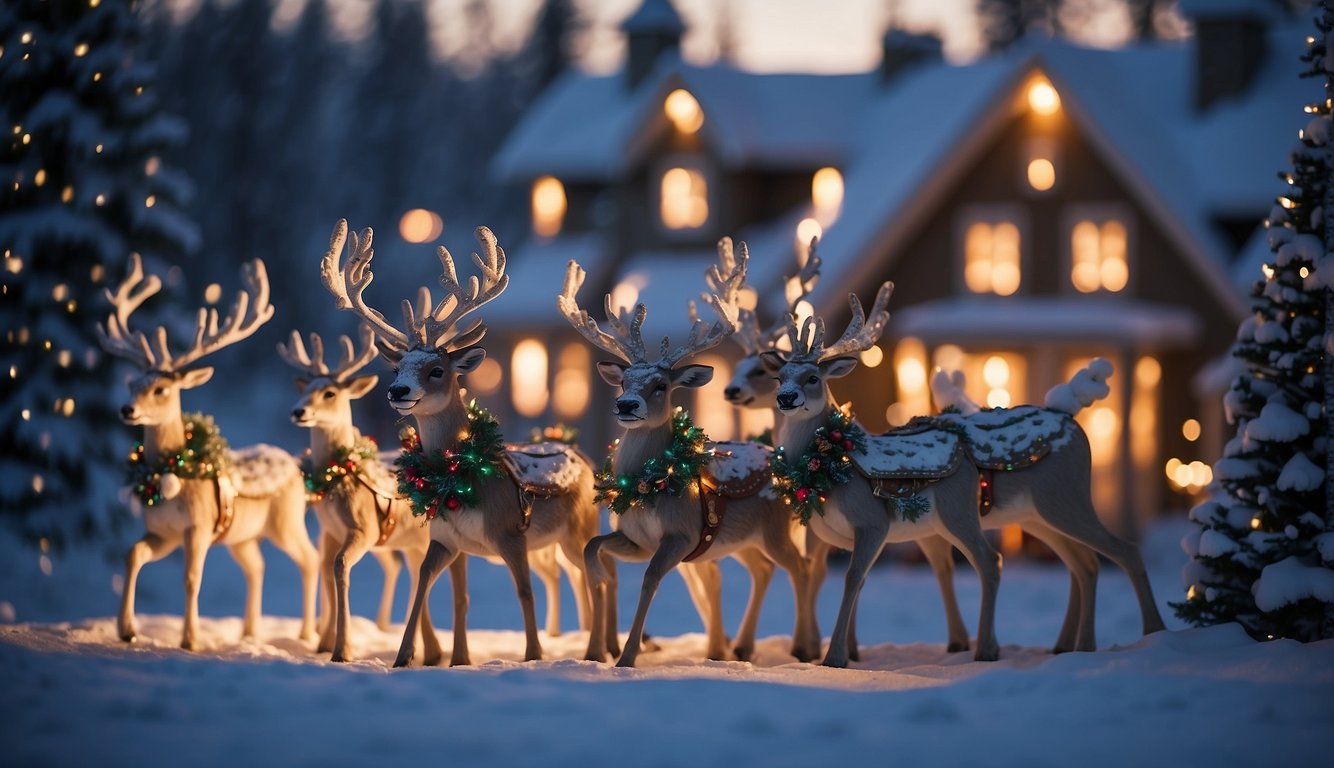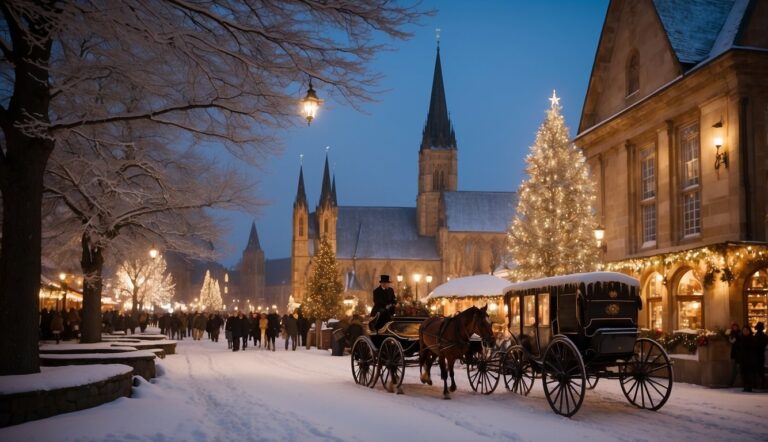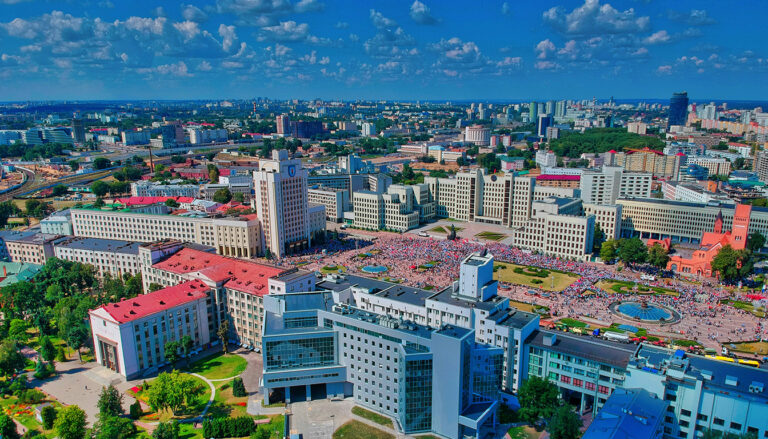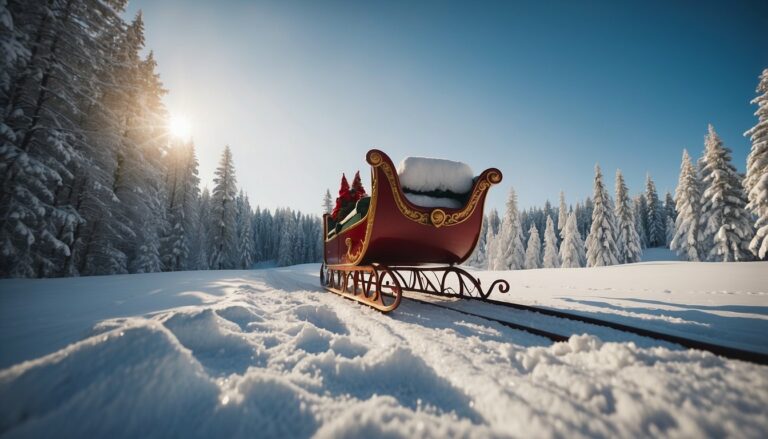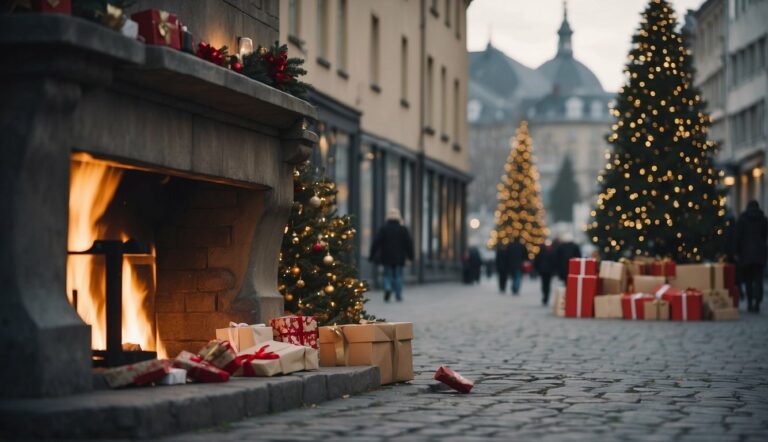Christmas in America: Traditions, Trends, and Celebration
Christmas in America is a vibrant and widely celebrated holiday, reflecting the nation’s diverse cultural heritage and traditions.
Originating as a religious festival, it has evolved into a season encompassing sacred meanings for some and secular enjoyment for others.
Throughout the United States, Americans embrace the spirit of the holiday in various ways, from the religious observance of Christmas Day itself to the extensive preparations and festivities that lead up to it.

The holiday has also been a commercial celebration, with businesses and homes adorned in elaborate decorations.
The emergence of year-round Christmas stores is a testament to American enthusiasm for the holiday. They satisfy a demand for festive décor that can be put up in homes and communities.
This commercial aspect coexists with cultural traditions such as the Christmas tree, which traces its roots to German immigrants and has become a hallmark of the season.
Americans have shaped Christmas into a holiday, emphasising familial warmth and community involvement.
Large family gatherings, reminiscent of Thanksgiving celebrations, are common on Christmas Day.
The exchange of gifts, inspired by the mythical figure of Santa Claus and traditions such as the performance of “The Nutcracker” ballet, have become ingrained in the American Christmas experience.
Each element contributes to the rich tapestry that makes Christmas in America a unique blend of the historical, the cultural, and the personal.
Historical Origins of Christmas
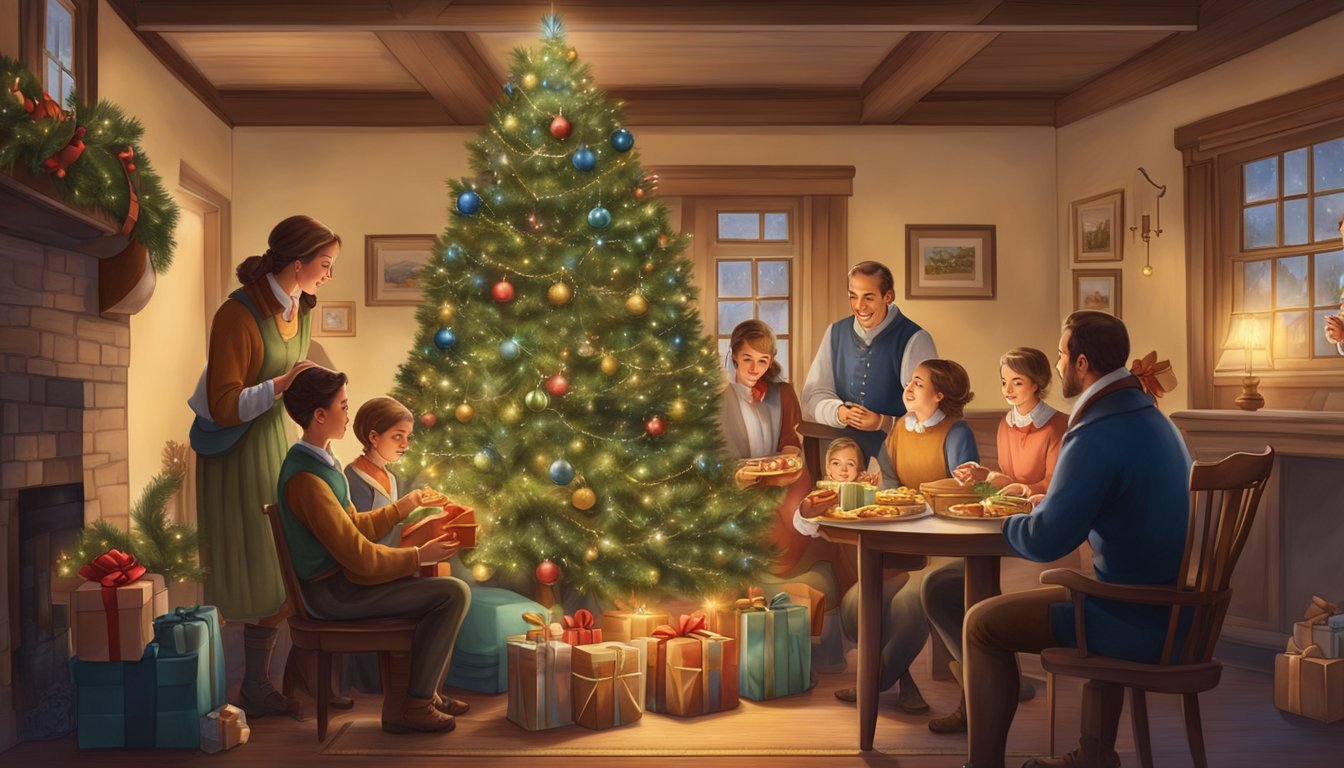
The celebration of Christmas in America is deeply rooted in European Christian traditions, modified by Puritan influence and evolved through American cultural adaptation. Declared a federal holiday in the late 19th century, it embodies religious heritage and secular customs.
European Roots and Puritan Influence
The origins of Christmas as a Christian holiday can be traced back to Europe, where it celebrated the birth of Jesus Christ.
With the migration of Europeans to the New World, these customs crossed the Atlantic.
However, the strict Puritanical forces in England, led by Oliver Cromwell, dramatically impacted the celebration of Christmas.
The Puritans in Massachusetts upheld similar stern perspectives, leading to a subdued acknowledgement of the holiday in early American society, particularly in New England.
Britons typically observed Christmas by attending church, then celebrating raucously in a drunken, carnival-like atmosphere known as “Christmastide.”
Puritan-led opposition to this manner of celebration influenced the observation of the holiday.
Boston even outlawed Christmas celebrations during the 17th century due to its non-scriptural origins and rowdy traditions.
Evolution of Christmas in America
In the 19th century, America saw a reinvention of Christmas.
The holiday transformed from a controversial, somewhat suppressed event to a more family-centred day of peace and nostalgia.
New York played a critical role in shaping the modern Christmas when, in 1822, Clement Clarke Moore’s poem “A Visit from St. Nicholas” was published, contributing significantly to the popularization of gift-giving and the figure of Santa Claus.
No longer a strictly religious festival, the reformed Christmas started incorporating various elements such as the decorated tree, a tradition brought by German and other European settlers.
These changes marked the secularization of Christmas, making it more inclusive for a nation of diverse ethnicities and religions.
Christmas as a Federal Holiday
On June 26, 1870, the United States Congress declared Christmas a federal holiday.
This designation reflected the growing importance of Christmas within American culture, unifying the celebration across a rapidly expanding nation.
It confirmed the holiday’s transition from divisive to central to America’s national identity.
By officially recognizing Christmas, the U.S. government sanctioned a Christian observance and a broader cultural event, signifying a shift towards a more unified national calendar of holidays significant to all, regardless of religious affiliation.
This inclusivity has resulted in a wide variety of ways the holiday is celebrated across the country, from religious services and family gatherings to public displays and community events.
Cultural Significance and Customs
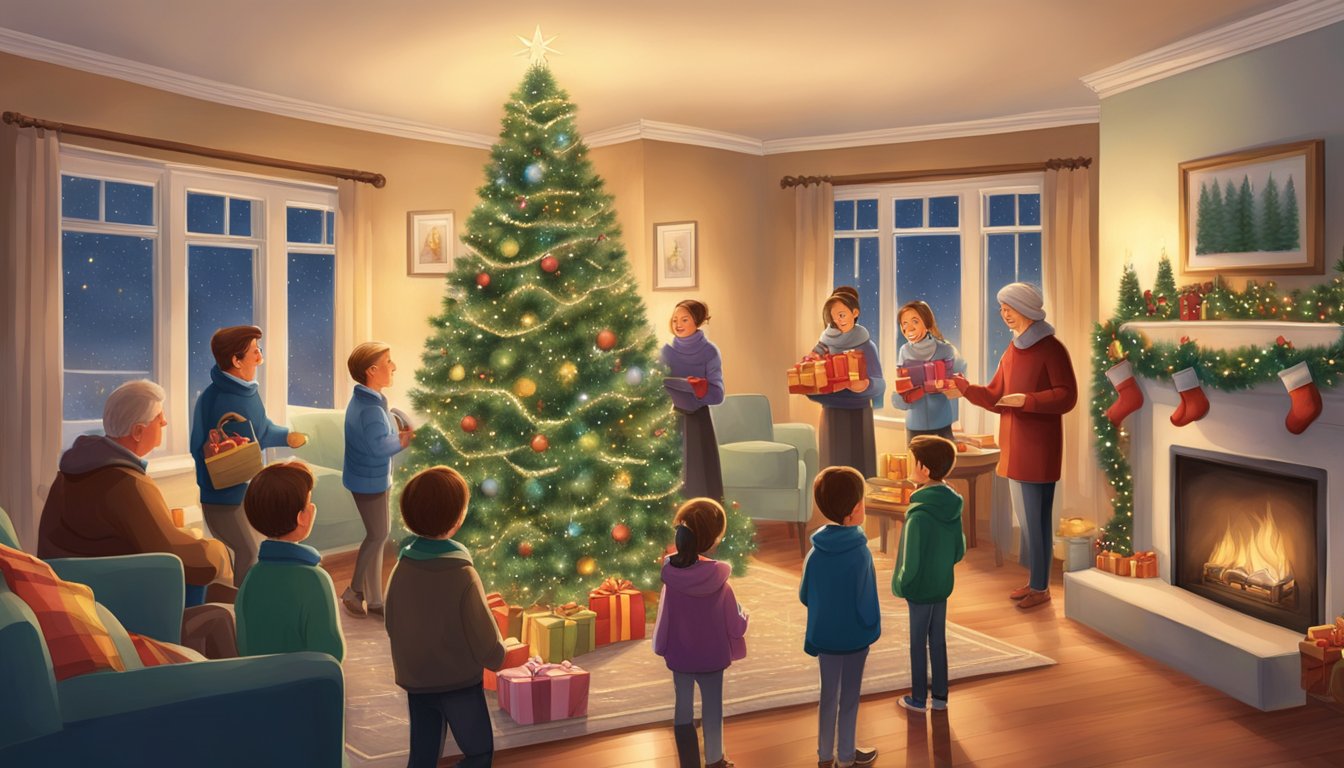
The celebration of Christmas in America is marked by a blend of religious reverence and widespread customs. These encompass church services commemorating the birth of Jesus and secular traditions such as Santa Claus and gift-giving.
Religious Observances
Christmas in America is a significant holiday for Christians who attend church services to celebrate the birth of Jesus.
Many American families participate in Midnight Mass on Christmas Eve or services on Christmas Day.
The nativity scene, depicting Mary, Joseph, and the baby Jesus, is commonly presented in churches and homes, highlighting the religious narrative of Christmas.
Folklore and Mythology
American Christmas folklore is rich with characters such as Santa Claus, also known as St. Nicholas, who is believed to deliver gifts to children on Christmas Eve.
Mythology includes his reindeer, Rudolph being the most famous, and elves said to assist in toy-making.
This blend of folklore gives American Christmas its unique enchanting appeal, especially to children.
Gift-Giving Traditions
The tradition of gift-giving centres around the exchange of presents, which is symbolic of the gifts given to Jesus by the three wise men.
Americans often place these gifts under a Christmas tree, a symbolic custom brought by German immigrants.
Stockings are also hung by the fireplace for Santa Claus to fill with presents.
This act of hanging stockings transforms homes into a place of festive generosity.
Iconic Christmas Symbols and Decoration
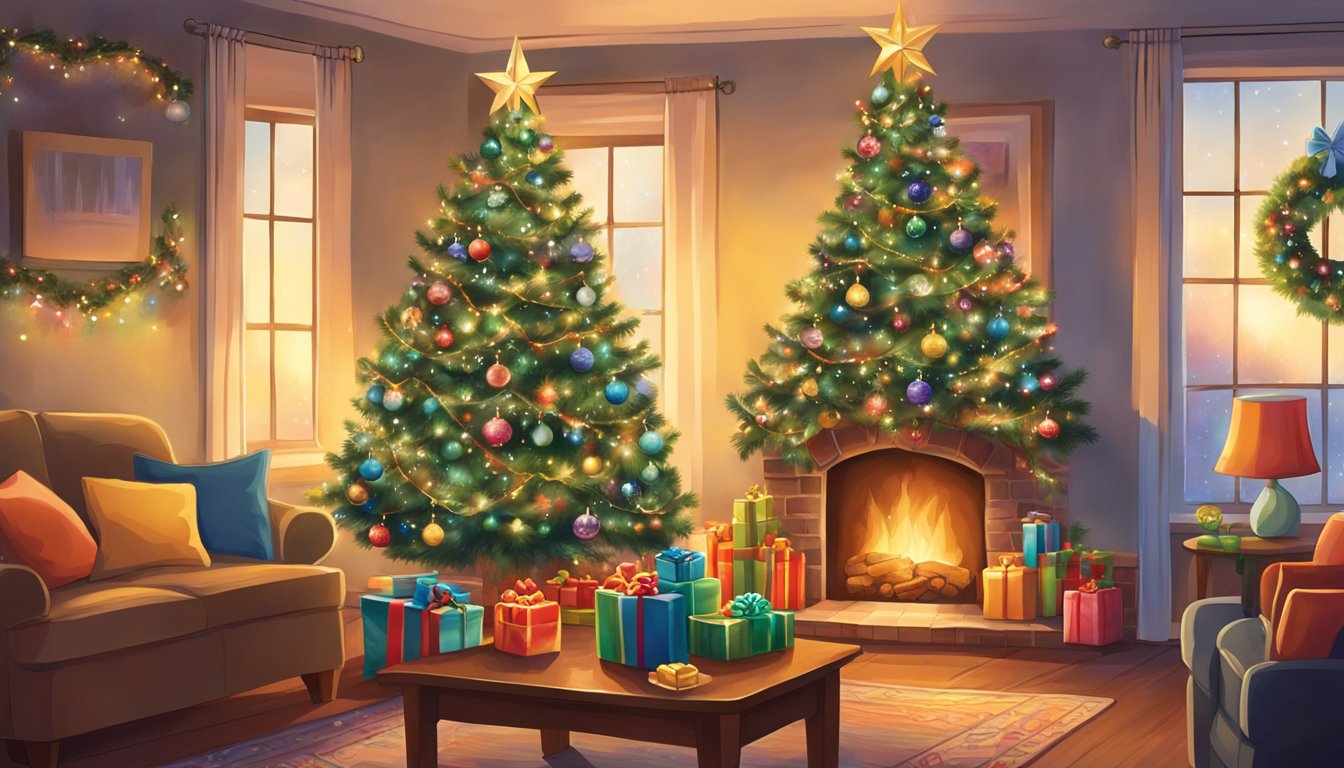
The symbols and decorations of Christmas in America are not only a sight to behold but also deeply rooted in tradition and history.
These elements play an integral role in holiday celebrations, from the twinkling lights illuminating neighbourhoods to the festive foods that grace dinner tables.
Christmas Trees and Ornaments
Christmas trees, a central emblem of the holiday, stand adorned with ornaments, tinsel, and Christmas lights, forming a cornerstone of American Christmas tradition.
Tree decorating dates back hundreds of years and remains a key custom for many.
Whether embellished with handcrafted heirlooms or the latest in ornament trends, these trees vary from home to home, each telling its story of holiday spirit.
Indoor and Outdoor Decorations
As December draws near, American homes and streets come to life with a variety of indoor and outdoor decorations.
Festive wreaths often adorn doors, while boughs of holly and mistletoe dangle from archways and mantles, inviting passersby to indulge in holiday cheer.
Christmas cards and holiday cards become both decoration and heartfelt messages of joy, displayed proudly on mantles and walls.
Outdoors, houses become illuminated displays, with Christmas lights outlining rooftops and landscapes transformed into winter wonderlands.
Special Christmas Foods
On Christmas Day, the air fills with the aroma of special Christmas foods.
Cookies and gingerbread houses offer festive flavors and activities for families who want to create and decorate these sweet treats.
Beverages like eggnog and a variety of hot chocolates become a staple to warm from the winter chill.
Main courses often feature traditional meats such as turkey and ham, completing the holiday feast that embodies the comfort and joy of the season.
Sweet Treats often include candy canes, Christmas cookies, and gingerbread creations.
Traditional Beverages like eggnog and hot chocolate are the drinks of choice.
Roast turkey or ham is commonly served during the Christmas meal.
Christmas Season Events and Entertainment

The holiday spirit in the United States comes alive with vibrant events that celebrate music, performance, and communal gatherings. These festivities, often steeped in tradition, are a core part of the Christmas experience across the nation.
Music and Caroling
Community groups and choirs often gather to perform Christmas carols in public spaces such as parks and town squares.
Rockefeller Center in New York City is renowned for its giant Christmas tree and the accompanying carolers, who add a musical backdrop to the bustling scene.
Visitors here can expect to hear classics like “Silent Night” and “Joy to the World” in the festive environment.
Holiday Performances and Movies
The Nutcracker is a staple holiday performance. Ballet companies across the United States stage “The Nutcracker” with its memorable music by Tchaikovsky and enchanting dance numbers.
Families often enjoy screenings of Christmas movies, with titles ranging from the timeless “It’s a Wonderful Life” to animated favourites such as “The Polar Express”.
Community and Family Activities
Christmas time is prime for parties where families and friends gather. These often feature gift exchanges, feasts, and games.
Santa’s Wonderland in Texas and Carmel Christkindlmarkt in Indiana host large-scale events with light displays and opportunities for shared joy among community members.
Many cities, including those with iconic venues like Rockefeller Center, offer ice skating as a classic family-friendly activity during the Christmas season.
Christmas Around America
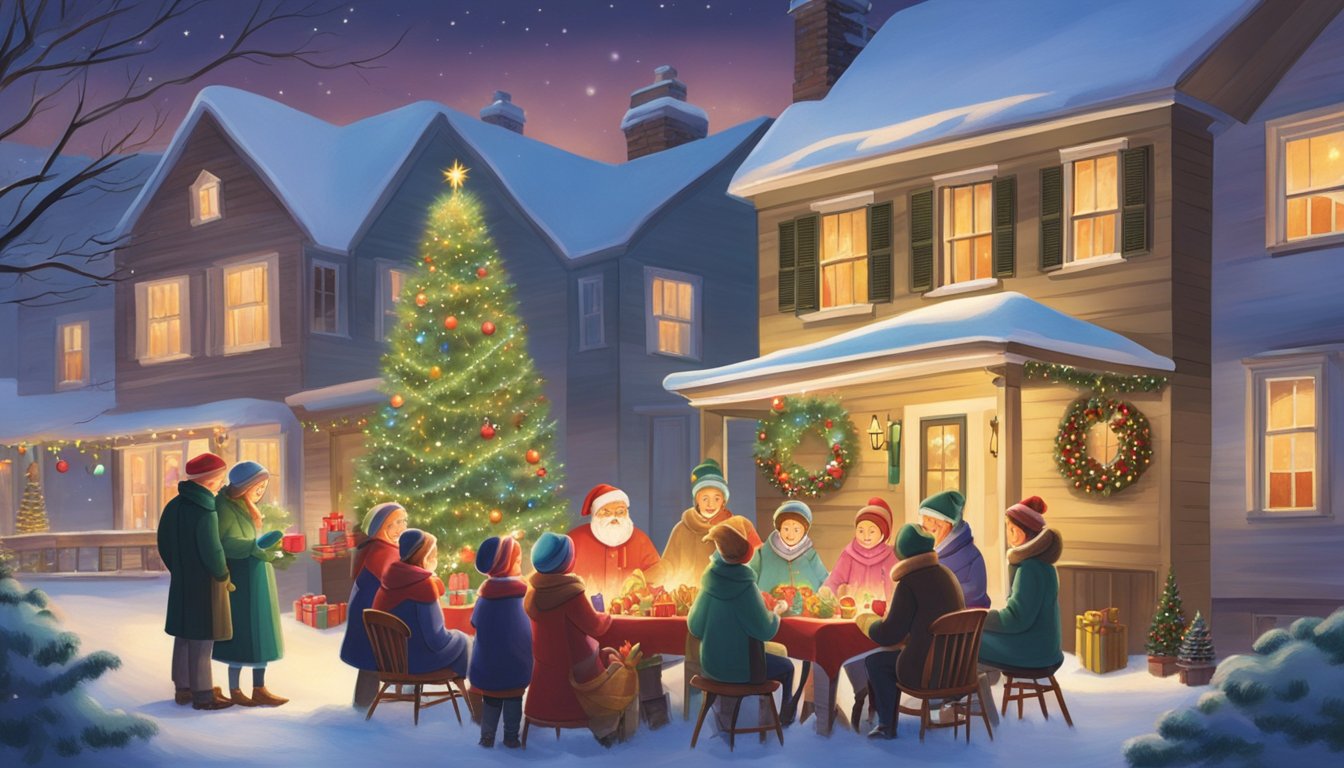
Christmas combines regional traditions, global influences, and intimate family celebrations in the United States. Each aspect contributes to the diverse and vibrant tapestry of how Americans celebrate the holiday season.
Regional Traditions
In the Southwestern states, luminarias, a tradition adopted from Mexico, illuminate pathways and homes with paper lanterns.
Meanwhile, in Pennsylvania, the earliest Christmas trees in America were introduced by German immigrants.
These regional customs showcase the mosaic of cultures that have shaped American society.
San Francisco is known for its performance of Tchaikovsky’s Nutcracker on Christmas Eve, a tradition that began in 1944 and has become a staple in American Christmas culture.
Regional celebrations of Christmas Eve vary, but many families attend midnight services or gather together to usher in December 25th.
Influence of Global Customs
The United States has incorporated numerous international traditions into its Christmas celebrations.
For instance, the ancient Roman festival of Saturnalia, with its spirit of merrymaking and gift-giving, has influenced modern Christmas festivities.
In the Middle Ages, Britain and Germany played pivotal roles in the development of Christmas customs, such as carolling and the Christmas tree, which have been embraced and adapted by American society.
Global customs have also left their mark, with many American families integrating practices from their ancestral homelands.
This tapestry of traditions reflects a broad appreciation for the global influence on how Americans celebrate Christmas.
Celebrating in the American Home
American families often celebrate Christmas with a mix of religious reverence and festive joy:
Many attend church services or reenact nativity scenes, honouring the Christian significance of Christmas.
Christmas Trees are a central feature in homes, adorned with ornaments, lights, and sometimes passed-down family heirlooms.
Exchanging gifts on Christmas morning is a beloved tradition for many.
Shared meals on Christmas Day often feature a variety of dishes, reflecting the diverse heritage of American society.
From Thanksgiving to Easter, the Christmas season is a time of heightened activity and anticipation.
In American homes, the traditions observed are as varied as the people, but they commonly centre around gathering with loved ones, sharing meals, and giving presents.
Modern Christmas

In contemporary American society, Christmas has become a complex holiday characterized by significant consumer spending, technological impacts, and alterations in traditional observances.
The Role of Consumerism
Christmas in America has undeniably transformed into a period of heightened consumer activity.
Shopping for gifts has become central to the holiday’s observance, with Americans collectively spending billions annually.
The season starts with Black Friday, a day marked by promotional sales and steep discounts, and continues with Cyber Monday, highlighting the prominence of online shopping.
Gifts have shifted from handcrafted items to a wide array of mass-produced goods, signifying the holiday’s growing commercial aspect.
Retailers and advertisers capitalize on this season, with the American public often beginning to purchase presents as early as October.
Technological Influence on Christmas
Technological advancements have dramatically shaped modern Christmas celebrations.
For example, electric Christmas lights, once a novel invention in the late 19th century, are now a staple in American holiday decor.
This tech-savvy era has also facilitated changes in how Americans shop and interact during the season.
E-commerce enables consumers to avoid crowded stores and easily purchase gifts from the comfort of their homes.
Social media and other online platforms are significant in spreading festive cheer and keeping friends and family connected, especially for those unable to gather in person.
Changes in Christmas Observances
The way Christmas is celebrated in America has seen notable changes over time, with the holiday expanding beyond its religious roots to encompass a variety of secular traditions and activities.
While many Americans still attend church services on Christmas Day, others may opt for secular forms of celebration such as dining, drinking, and merry-making.
Family gatherings, festive meals, and charitable giving also illustrate how the holiday emphasizes togetherness and generosity in American society.
Throughout these changes in the holiday’s celebration, the spirit of Christmas continues to be embraced by a diverse range of people across America, reflecting the holiday’s capacity to adapt and grow within the nation’s cultural fabric.
Notable Christmas Figures and Stories
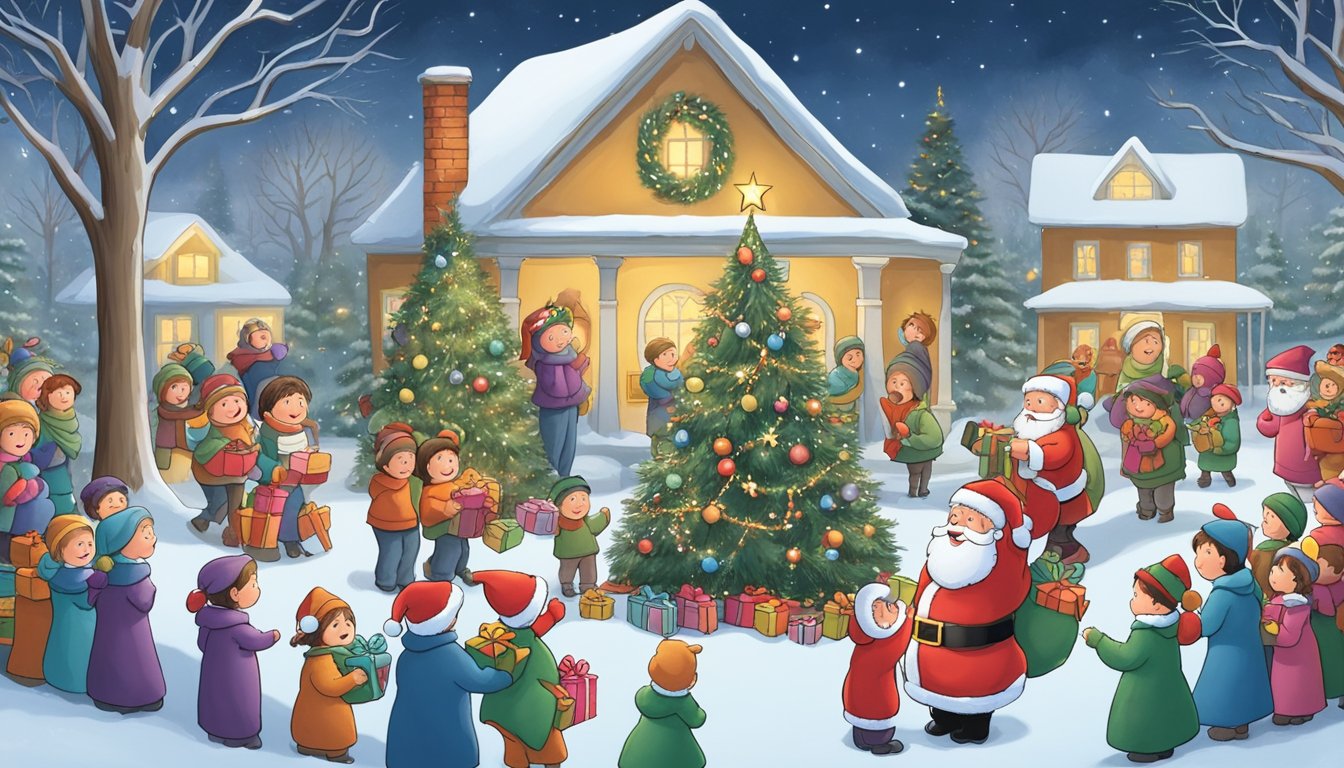
The transformation of Saint Nicholas into the iconic Santa Claus and the historical and literary influences on American Christmas traditions have shaped the celebration of Christmas in America.
Saint Nicholas to Santa Claus
Saint Nicholas, a 4th-century bishop from Myra, now part of modern-day Turkey, evolved into the jolly, gift-giving figure of Santa Claus in American culture.
The character of Santa Claus was further popularized in the 19th century through the works of authors such as Washington Irving and Thomas Nast’s political cartoons.
Nast’s drawings depicted a merry Santa that contributed significantly to the modern image of Santa with his red suit and white beard.
Historical and Literary Influences
Various cultures, including elements from England and Rome, have influenced the origins of Christmas in America.
The ancient Roman festival of Saturnalia parallels modern Christmas celebrations.
Furthermore, Queen Victoria and her German consort, Prince Albert, popularized the Christmas tree in England, subsequently influencing Christmas celebrations in America.
Certain literary works have also played a pivotal role in shaping American Christmas customs.
Charles Dickens’s 1843 novella A Christmas Carol promoted the themes of generosity and compassion, intertwining them with the Christmas spirit.
Dickens’s work profoundly impacted the celebration of Christmas as a time for family and the remembrance of the less fortunate.

Christmas in America embodies a rich tapestry of traditions that reflect the diverse cultural heritage of its people. As Americans gather to celebrate Christmas, the holiday acts as a unifying force, bringing together friends and family to cherish shared moments and spread generosity.
It is seen in the quintessential Christmas trees, originating from German immigrants to the universal figure of Santa Claus, whose modern conception owes much to the writings of Washington Irving.
Many Americans maintain a connection to the holiday’s religious roots, with many affirming the nativity story’s elements as historical events.
Despite evolving sentiments and beliefs, Christmas maintains its status as a cornerstone of the winter season for many Americans.
During this time, the nation’s emphasis on love, joy, and communal spirit resonates.
As Christmas is celebrated year after year in the United States, it serves not only as a reminder of cultural and historical narratives but also as an occasion to exemplify the virtues of kindness and goodwill cherished across the nation.
Frequently Asked Questions

How do Americans typically celebrate Christmas?
Americans commonly celebrate Christmas with gatherings of family and friends, sharing a meal that often includes roast turkey or ham.
Homes are decorated with lights, Christmas trees, and other festive adornments.
What are some unique Christmas traditions in the United States?
Unique traditions in the United States include the National Christmas Tree Lighting in Washington D.C. and the Christmas Spectacular starring the Radio City Rockettes in New York.
Some areas feature distinctive displays like lobster trap Christmas trees in coastal towns.
What is the historical background of Christmas celebrations in America?
Christmas celebrations in America have evolved, with many traditions originating from European customs.
The Spanish in Florida celebrated the first Christmas in the United States in 1539, and the holiday has since become a melting pot of cultural practices.
How do American children typically experience Christmas?
Children in America often experience Christmas with great anticipation for Santa Claus, who is said to deliver presents on Christmas Eve.
They engage in activities like cookie baking, writing letters to Santa, and attending family holiday events.
What are some popular American Christmas songs and their significance?
Popular songs like “Christmas in America” capture the spirit of the season, emphasizing unity and joy.
Classics such as “Jingle Bells” and “Silent Night” are staples of holiday music, often reflecting the cultural diversity and celebratory nature of American Christmases.
What notable movies encapsulate the Christmas spirit in America?
Notable Christmas movies that embody the American holiday spirit include “It’s a Wonderful Life” and “A Christmas Story.” These films highlight themes of family, generosity, and the season’s magic.
These films are widely beloved and often become a part of family holiday traditions.

